Quick filters:
King mesha of moab Stock Photos and Images
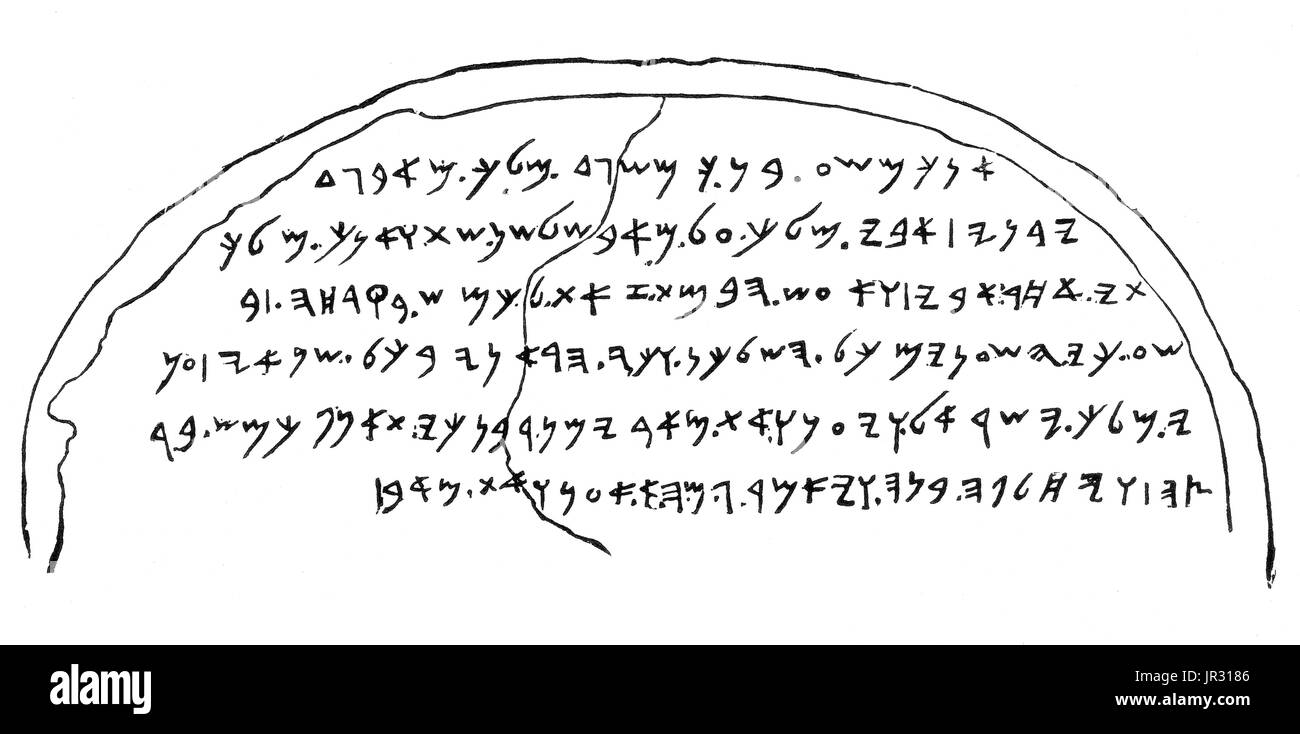 The Mesha Stele (Moabite Stone) is a stele set up around 840 BCE by King Mesha of Moab (a kingdom located in modern Jordan). Mesha tells how Chemosh, the god of Moab, had been angry with his people and had allowed them to be subjugated to Israel, but at length Chemosh returned and assisted Mesha to throw off the yoke of Israel and restore the lands of Moab. Mesha describes his many building projects. It is written in the Phoenician alphabet. The Mesha stele is the longest Iron Age inscription ever found in the region, constitutes the major evidence for the Moabite language, and is a 'corner-st Stock Photohttps://www.alamy.com/image-license-details/?v=1https://www.alamy.com/the-mesha-stele-moabite-stone-is-a-stele-set-up-around-840-bce-by-image151886902.html
The Mesha Stele (Moabite Stone) is a stele set up around 840 BCE by King Mesha of Moab (a kingdom located in modern Jordan). Mesha tells how Chemosh, the god of Moab, had been angry with his people and had allowed them to be subjugated to Israel, but at length Chemosh returned and assisted Mesha to throw off the yoke of Israel and restore the lands of Moab. Mesha describes his many building projects. It is written in the Phoenician alphabet. The Mesha stele is the longest Iron Age inscription ever found in the region, constitutes the major evidence for the Moabite language, and is a 'corner-st Stock Photohttps://www.alamy.com/image-license-details/?v=1https://www.alamy.com/the-mesha-stele-moabite-stone-is-a-stele-set-up-around-840-bce-by-image151886902.htmlRMJR3186–The Mesha Stele (Moabite Stone) is a stele set up around 840 BCE by King Mesha of Moab (a kingdom located in modern Jordan). Mesha tells how Chemosh, the god of Moab, had been angry with his people and had allowed them to be subjugated to Israel, but at length Chemosh returned and assisted Mesha to throw off the yoke of Israel and restore the lands of Moab. Mesha describes his many building projects. It is written in the Phoenician alphabet. The Mesha stele is the longest Iron Age inscription ever found in the region, constitutes the major evidence for the Moabite language, and is a 'corner-st
 The Moabite Stone is a stele set up around 840 BCE by King Mesha of Moab, vintage line drawing or engraving illustration. Stock Vectorhttps://www.alamy.com/image-license-details/?v=1https://www.alamy.com/the-moabite-stone-is-a-stele-set-up-around-840-bce-by-king-mesha-of-moab-vintage-line-drawing-or-engraving-illustration-image244634927.html
The Moabite Stone is a stele set up around 840 BCE by King Mesha of Moab, vintage line drawing or engraving illustration. Stock Vectorhttps://www.alamy.com/image-license-details/?v=1https://www.alamy.com/the-moabite-stone-is-a-stele-set-up-around-840-bce-by-king-mesha-of-moab-vintage-line-drawing-or-engraving-illustration-image244634927.htmlRFT6029K–The Moabite Stone is a stele set up around 840 BCE by King Mesha of Moab, vintage line drawing or engraving illustration.
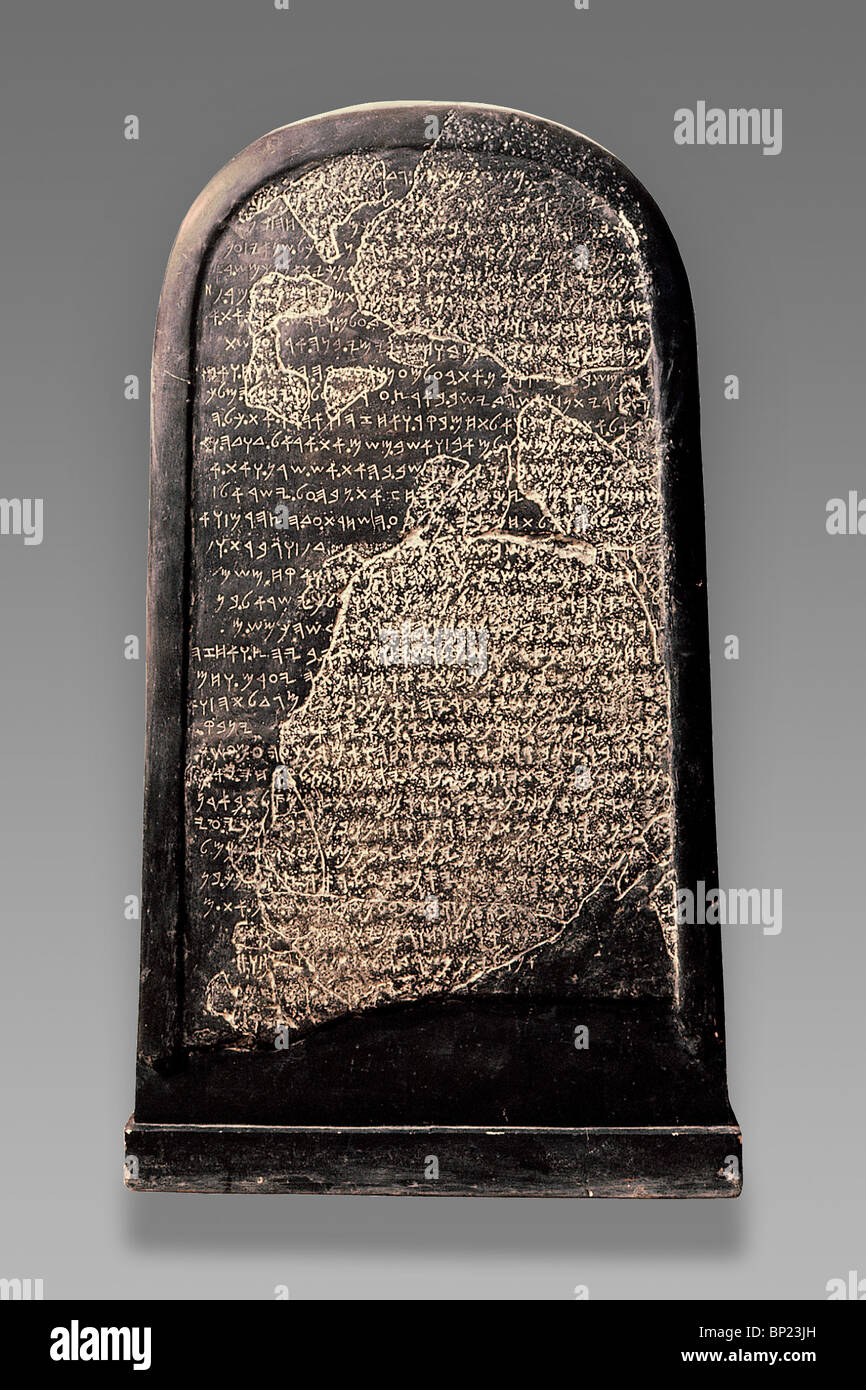 229. MESHA STELE, A MOABITE INSCRIPTION DATING CA. 840-820 B.C. RECOUNTING THE EXPLOITS OF MESHA KING OF MOAB Stock Photohttps://www.alamy.com/image-license-details/?v=1https://www.alamy.com/stock-photo-229-mesha-stele-a-moabite-inscription-dating-ca-840-820-bc-recounting-30779577.html
229. MESHA STELE, A MOABITE INSCRIPTION DATING CA. 840-820 B.C. RECOUNTING THE EXPLOITS OF MESHA KING OF MOAB Stock Photohttps://www.alamy.com/image-license-details/?v=1https://www.alamy.com/stock-photo-229-mesha-stele-a-moabite-inscription-dating-ca-840-820-bc-recounting-30779577.htmlRMBP23JH–229. MESHA STELE, A MOABITE INSCRIPTION DATING CA. 840-820 B.C. RECOUNTING THE EXPLOITS OF MESHA KING OF MOAB
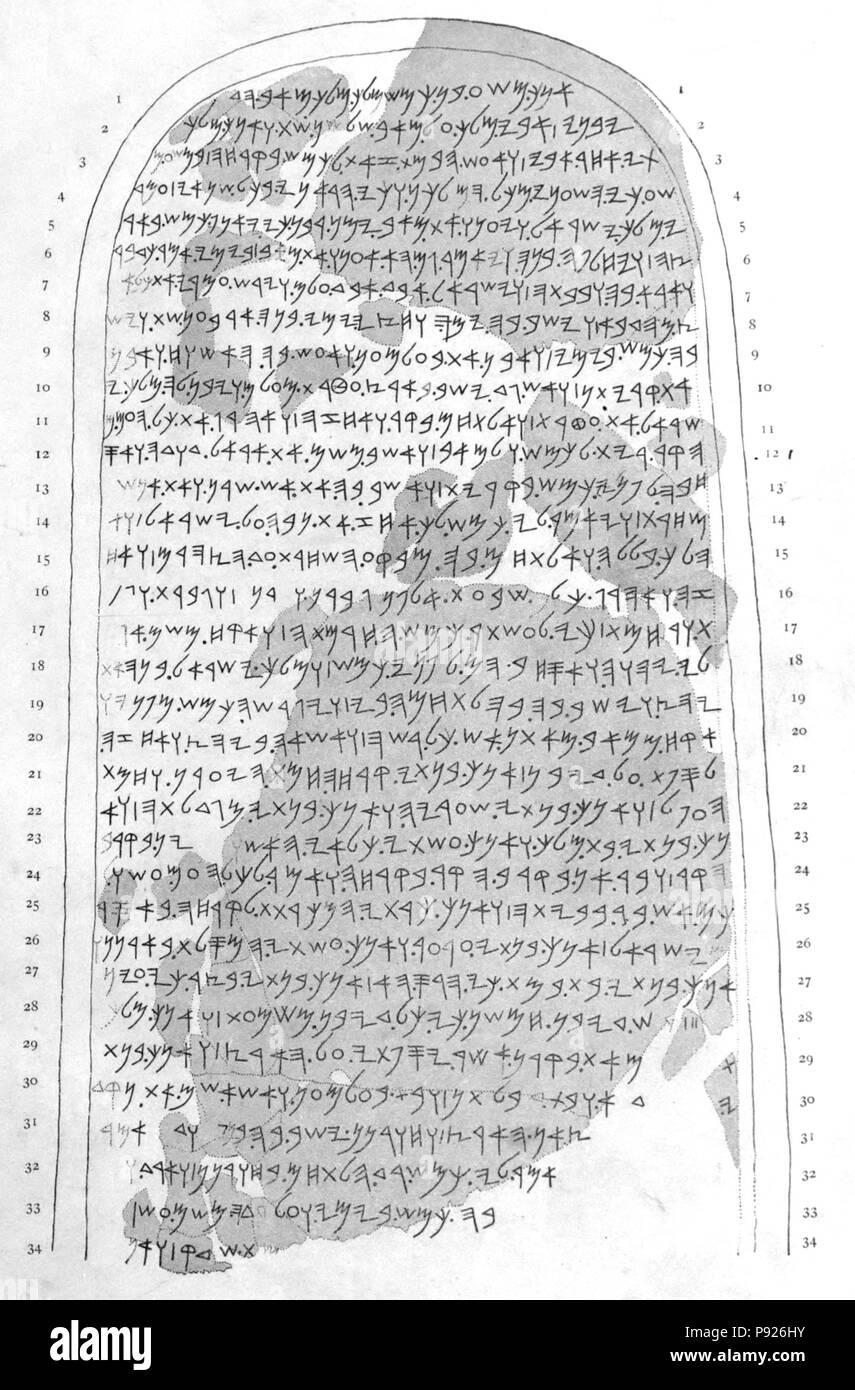 417 Mesha Stele drawing Stock Photohttps://www.alamy.com/image-license-details/?v=1https://www.alamy.com/417-mesha-stele-drawing-image212105431.html
417 Mesha Stele drawing Stock Photohttps://www.alamy.com/image-license-details/?v=1https://www.alamy.com/417-mesha-stele-drawing-image212105431.htmlRMP926HY–417 Mesha Stele drawing
![The Mesha Stele, also known as the Moabite Stone, is a stele dated around 840 BCE containing a significant Canaanite inscription in the name of King Mesha of Moab (a kingdom located in modern Jordan). Mesha tells how Chemosh, the god of Moab, had been angry with his people and had allowed them to be subjugated to the Kingdom of Israel, but at length, Chemosh returned and assisted Mesha to throw off the yoke of Israel and restore the lands of Moab. Mesha also describes his many building projects.[1] It is written in a variant of the Phoenician alphabet, closely related to the Paleo-Hebrew scrip Stock Photo The Mesha Stele, also known as the Moabite Stone, is a stele dated around 840 BCE containing a significant Canaanite inscription in the name of King Mesha of Moab (a kingdom located in modern Jordan). Mesha tells how Chemosh, the god of Moab, had been angry with his people and had allowed them to be subjugated to the Kingdom of Israel, but at length, Chemosh returned and assisted Mesha to throw off the yoke of Israel and restore the lands of Moab. Mesha also describes his many building projects.[1] It is written in a variant of the Phoenician alphabet, closely related to the Paleo-Hebrew scrip Stock Photo](https://c8.alamy.com/comp/3AAH0HT/the-mesha-stele-also-known-as-the-moabite-stone-is-a-stele-dated-around-840-bce-containing-a-significant-canaanite-inscription-in-the-name-of-king-mesha-of-moab-a-kingdom-located-in-modern-jordan-mesha-tells-how-chemosh-the-god-of-moab-had-been-angry-with-his-people-and-had-allowed-them-to-be-subjugated-to-the-kingdom-of-israel-but-at-length-chemosh-returned-and-assisted-mesha-to-throw-off-the-yoke-of-israel-and-restore-the-lands-of-moab-mesha-also-describes-his-many-building-projects-1-it-is-written-in-a-variant-of-the-phoenician-alphabet-closely-related-to-the-paleo-hebrew-scrip-3AAH0HT.jpg) The Mesha Stele, also known as the Moabite Stone, is a stele dated around 840 BCE containing a significant Canaanite inscription in the name of King Mesha of Moab (a kingdom located in modern Jordan). Mesha tells how Chemosh, the god of Moab, had been angry with his people and had allowed them to be subjugated to the Kingdom of Israel, but at length, Chemosh returned and assisted Mesha to throw off the yoke of Israel and restore the lands of Moab. Mesha also describes his many building projects.[1] It is written in a variant of the Phoenician alphabet, closely related to the Paleo-Hebrew scrip Stock Photohttps://www.alamy.com/image-license-details/?v=1https://www.alamy.com/the-mesha-stele-also-known-as-the-moabite-stone-is-a-stele-dated-around-840-bce-containing-a-significant-canaanite-inscription-in-the-name-of-king-mesha-of-moab-a-kingdom-located-in-modern-jordan-mesha-tells-how-chemosh-the-god-of-moab-had-been-angry-with-his-people-and-had-allowed-them-to-be-subjugated-to-the-kingdom-of-israel-but-at-length-chemosh-returned-and-assisted-mesha-to-throw-off-the-yoke-of-israel-and-restore-the-lands-of-moab-mesha-also-describes-his-many-building-projects-1-it-is-written-in-a-variant-of-the-phoenician-alphabet-closely-related-to-the-paleo-hebrew-scrip-image660514228.html
The Mesha Stele, also known as the Moabite Stone, is a stele dated around 840 BCE containing a significant Canaanite inscription in the name of King Mesha of Moab (a kingdom located in modern Jordan). Mesha tells how Chemosh, the god of Moab, had been angry with his people and had allowed them to be subjugated to the Kingdom of Israel, but at length, Chemosh returned and assisted Mesha to throw off the yoke of Israel and restore the lands of Moab. Mesha also describes his many building projects.[1] It is written in a variant of the Phoenician alphabet, closely related to the Paleo-Hebrew scrip Stock Photohttps://www.alamy.com/image-license-details/?v=1https://www.alamy.com/the-mesha-stele-also-known-as-the-moabite-stone-is-a-stele-dated-around-840-bce-containing-a-significant-canaanite-inscription-in-the-name-of-king-mesha-of-moab-a-kingdom-located-in-modern-jordan-mesha-tells-how-chemosh-the-god-of-moab-had-been-angry-with-his-people-and-had-allowed-them-to-be-subjugated-to-the-kingdom-of-israel-but-at-length-chemosh-returned-and-assisted-mesha-to-throw-off-the-yoke-of-israel-and-restore-the-lands-of-moab-mesha-also-describes-his-many-building-projects-1-it-is-written-in-a-variant-of-the-phoenician-alphabet-closely-related-to-the-paleo-hebrew-scrip-image660514228.htmlRM3AAH0HT–The Mesha Stele, also known as the Moabite Stone, is a stele dated around 840 BCE containing a significant Canaanite inscription in the name of King Mesha of Moab (a kingdom located in modern Jordan). Mesha tells how Chemosh, the god of Moab, had been angry with his people and had allowed them to be subjugated to the Kingdom of Israel, but at length, Chemosh returned and assisted Mesha to throw off the yoke of Israel and restore the lands of Moab. Mesha also describes his many building projects.[1] It is written in a variant of the Phoenician alphabet, closely related to the Paleo-Hebrew scrip
 Mesha Stele, a black basalt stone with an inscription in the Moabite language from the Moabite King Mesa, 9th century BC, Dhiban or Diban Stock Photohttps://www.alamy.com/image-license-details/?v=1https://www.alamy.com/mesha-stele-a-black-basalt-stone-with-an-inscription-in-the-moabite-language-from-the-moabite-king-mesa-9th-century-bc-dhiban-or-diban-image364685448.html
Mesha Stele, a black basalt stone with an inscription in the Moabite language from the Moabite King Mesa, 9th century BC, Dhiban or Diban Stock Photohttps://www.alamy.com/image-license-details/?v=1https://www.alamy.com/mesha-stele-a-black-basalt-stone-with-an-inscription-in-the-moabite-language-from-the-moabite-king-mesa-9th-century-bc-dhiban-or-diban-image364685448.htmlRM2C58T08–Mesha Stele, a black basalt stone with an inscription in the Moabite language from the Moabite King Mesa, 9th century BC, Dhiban or Diban
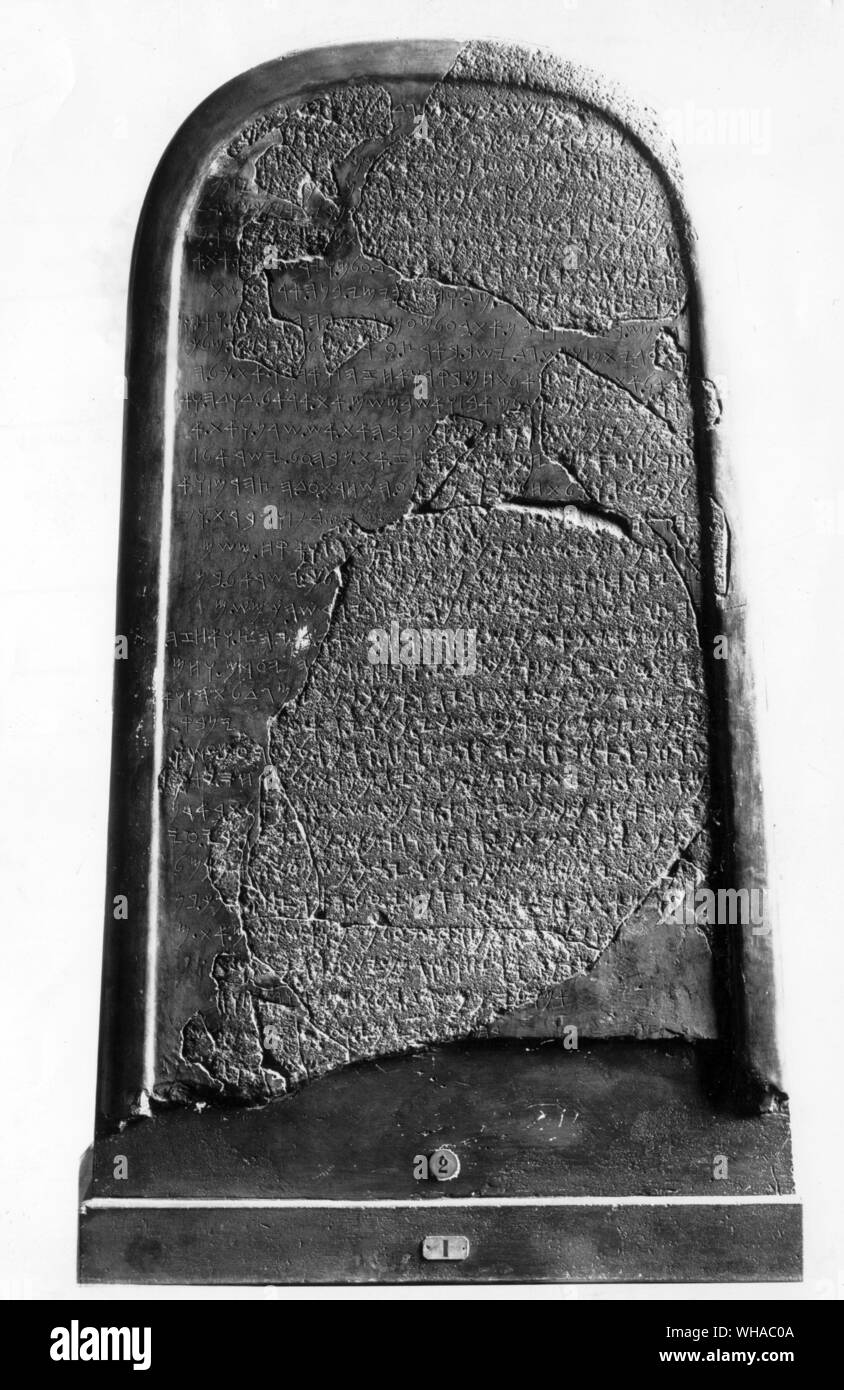 The Stone of Mesha. The Mesha or Moabite Stone, is an ancient Palestinian slab that became the first definite inscribed evidence of an Old Testament event. ..... The slab was discovered in Dibon, Jordan (1868) by F. A. Klein, a German clergyman. It was a five foot stone recording, in a dialect similar to Hebrew, the events of Moabite and Israelite history. The inscription dates from c. 850 B.C. It was erected by Mesha, king of Moab, and is often styled the Mesha Stone. When Klein attempted to purchase it from the Arabs, it was broken into fragments. Fortunately, most of the pieces were Stock Photohttps://www.alamy.com/image-license-details/?v=1https://www.alamy.com/the-stone-of-mesha-the-mesha-or-moabite-stone-is-an-ancient-palestinian-slab-that-became-the-first-definite-inscribed-evidence-of-an-old-testament-event-the-slab-was-discovered-in-dibon-jordan-1868-by-f-a-klein-a-german-clergyman-it-was-a-five-foot-stone-recording-in-a-dialect-similar-to-hebrew-the-events-of-moabite-and-israelite-history-the-inscription-dates-from-c-850-bc-it-was-erected-by-mesha-king-of-moab-and-is-often-styled-the-mesha-stone-when-klein-attempted-to-purchase-it-from-the-arabs-it-was-broken-into-fragments-fortunately-most-of-the-pieces-were-image268833610.html
The Stone of Mesha. The Mesha or Moabite Stone, is an ancient Palestinian slab that became the first definite inscribed evidence of an Old Testament event. ..... The slab was discovered in Dibon, Jordan (1868) by F. A. Klein, a German clergyman. It was a five foot stone recording, in a dialect similar to Hebrew, the events of Moabite and Israelite history. The inscription dates from c. 850 B.C. It was erected by Mesha, king of Moab, and is often styled the Mesha Stone. When Klein attempted to purchase it from the Arabs, it was broken into fragments. Fortunately, most of the pieces were Stock Photohttps://www.alamy.com/image-license-details/?v=1https://www.alamy.com/the-stone-of-mesha-the-mesha-or-moabite-stone-is-an-ancient-palestinian-slab-that-became-the-first-definite-inscribed-evidence-of-an-old-testament-event-the-slab-was-discovered-in-dibon-jordan-1868-by-f-a-klein-a-german-clergyman-it-was-a-five-foot-stone-recording-in-a-dialect-similar-to-hebrew-the-events-of-moabite-and-israelite-history-the-inscription-dates-from-c-850-bc-it-was-erected-by-mesha-king-of-moab-and-is-often-styled-the-mesha-stone-when-klein-attempted-to-purchase-it-from-the-arabs-it-was-broken-into-fragments-fortunately-most-of-the-pieces-were-image268833610.htmlRMWHAC0A–The Stone of Mesha. The Mesha or Moabite Stone, is an ancient Palestinian slab that became the first definite inscribed evidence of an Old Testament event. ..... The slab was discovered in Dibon, Jordan (1868) by F. A. Klein, a German clergyman. It was a five foot stone recording, in a dialect similar to Hebrew, the events of Moabite and Israelite history. The inscription dates from c. 850 B.C. It was erected by Mesha, king of Moab, and is often styled the Mesha Stone. When Klein attempted to purchase it from the Arabs, it was broken into fragments. Fortunately, most of the pieces were
 Mesha Stele or Moabite Stone, black basalt stone,inscription in the Moabite language from the Moabite King Mesa, 9th century BC, Stock Photohttps://www.alamy.com/image-license-details/?v=1https://www.alamy.com/stock-photo-mesha-stele-or-moabite-stone-black-basalt-stoneinscription-in-the-75404232.html
Mesha Stele or Moabite Stone, black basalt stone,inscription in the Moabite language from the Moabite King Mesa, 9th century BC, Stock Photohttps://www.alamy.com/image-license-details/?v=1https://www.alamy.com/stock-photo-mesha-stele-or-moabite-stone-black-basalt-stoneinscription-in-the-75404232.htmlRMEAJXT8–Mesha Stele or Moabite Stone, black basalt stone,inscription in the Moabite language from the Moabite King Mesa, 9th century BC,
 7399. The El-Kerak inscription in Moabite language, was either written by Mesha, king of Moab, or his father in the 9th century B.C.E Stock Photohttps://www.alamy.com/image-license-details/?v=1https://www.alamy.com/7399-the-el-kerak-inscription-in-moabite-language-was-either-written-by-mesha-king-of-moab-or-his-father-in-the-9th-century-bce-image632115217.html
7399. The El-Kerak inscription in Moabite language, was either written by Mesha, king of Moab, or his father in the 9th century B.C.E Stock Photohttps://www.alamy.com/image-license-details/?v=1https://www.alamy.com/7399-the-el-kerak-inscription-in-moabite-language-was-either-written-by-mesha-king-of-moab-or-his-father-in-the-9th-century-bce-image632115217.htmlRF2YMB9BD–7399. The El-Kerak inscription in Moabite language, was either written by Mesha, king of Moab, or his father in the 9th century B.C.E
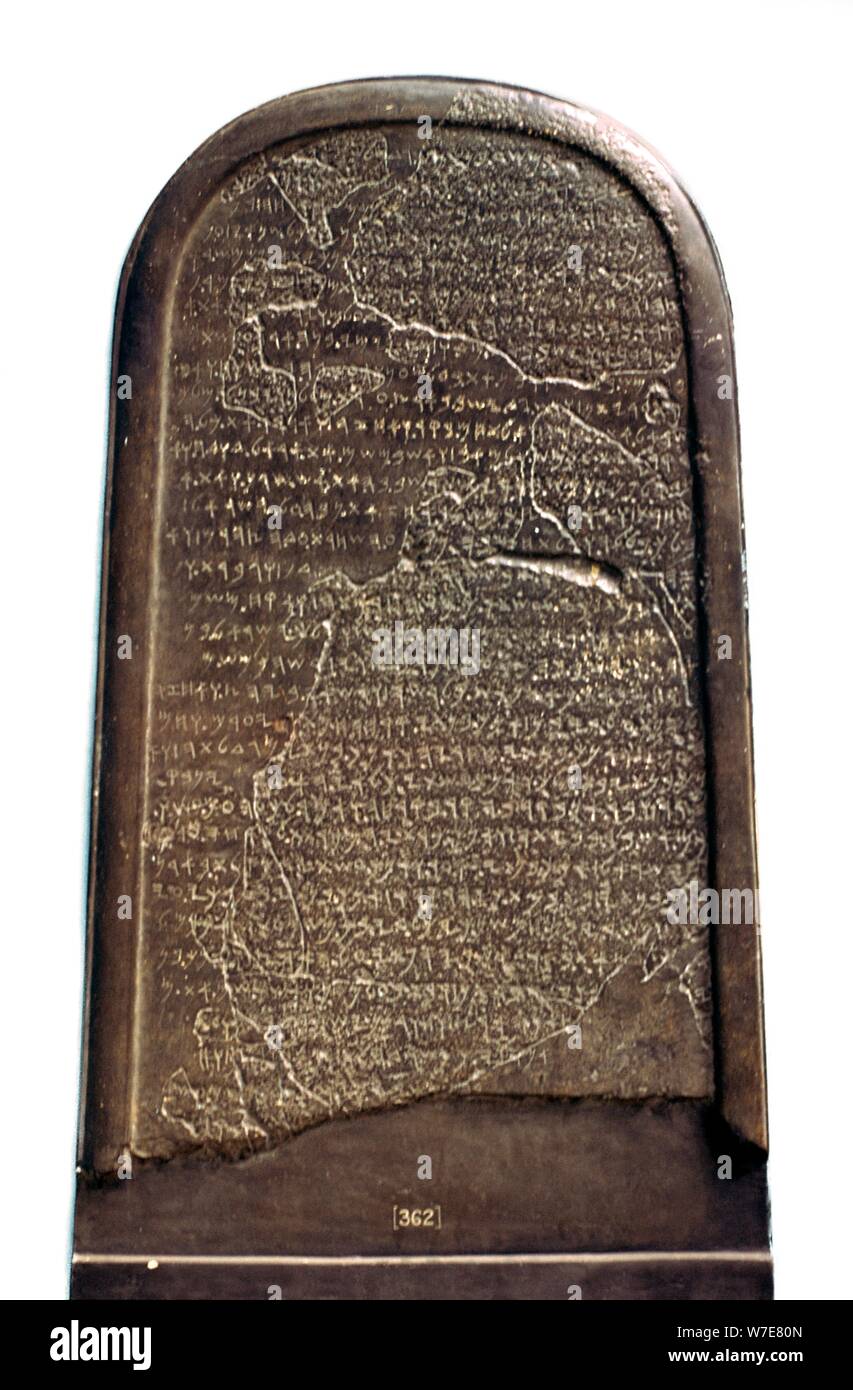 Stela with hebrew script commemorating a successful revolt, 9th century BC. Artist: Unknown Stock Photohttps://www.alamy.com/image-license-details/?v=1https://www.alamy.com/stela-with-hebrew-script-commemorating-a-successful-revolt-9th-century-bc-artist-unknown-image262771733.html
Stela with hebrew script commemorating a successful revolt, 9th century BC. Artist: Unknown Stock Photohttps://www.alamy.com/image-license-details/?v=1https://www.alamy.com/stela-with-hebrew-script-commemorating-a-successful-revolt-9th-century-bc-artist-unknown-image262771733.htmlRMW7E80N–Stela with hebrew script commemorating a successful revolt, 9th century BC. Artist: Unknown
 7496. Inscribed Moabite Altar from Khirbat Ataruz, Jordan, Mentions the Biblical Rebellion of Mesha, King of Moab who rebelled and won Ataroth from th Stock Photohttps://www.alamy.com/image-license-details/?v=1https://www.alamy.com/7496-inscribed-moabite-altar-from-khirbat-ataruz-jordan-mentions-the-biblical-rebellion-of-mesha-king-of-moab-who-rebelled-and-won-ataroth-from-th-image644206277.html
7496. Inscribed Moabite Altar from Khirbat Ataruz, Jordan, Mentions the Biblical Rebellion of Mesha, King of Moab who rebelled and won Ataroth from th Stock Photohttps://www.alamy.com/image-license-details/?v=1https://www.alamy.com/7496-inscribed-moabite-altar-from-khirbat-ataruz-jordan-mentions-the-biblical-rebellion-of-mesha-king-of-moab-who-rebelled-and-won-ataroth-from-th-image644206277.htmlRF2SC23K1–7496. Inscribed Moabite Altar from Khirbat Ataruz, Jordan, Mentions the Biblical Rebellion of Mesha, King of Moab who rebelled and won Ataroth from th
 A history of all nations from the earliest times; being a universal historical library . Flö.ö-Tbc(.l»r>>k o, Shahua.uM, 1,1 u k Ki.iU London, British Museum.. Fig. 8, A.—Moabite stone recording the vi tories of King Mesha of Moab over Israel.History of All Natioiw, Vol. II., patie US. KING MESITA OF MO AB. 63 Bible, had assailed Samaria, but had been defeated by Ahab at Aphek(now Fik), to the east of the Lake of Tiberias. On the approachof the Assyrians we find both these princes, as Avell as Irkhulina ofHamath, Adonibaal of Byblos, and the kings of the Chatti andof the Mediterranean co Stock Photohttps://www.alamy.com/image-license-details/?v=1https://www.alamy.com/a-history-of-all-nations-from-the-earliest-times-being-a-universal-historical-library-fl-tbclrgtgtk-o-shahuaum-11-u-k-kiiu-london-british-museum-fig-8-amoabite-stone-recording-the-vi-tories-of-king-mesha-of-moab-over-israelhistory-of-all-natioiw-vol-ii-patie-us-king-mesita-of-mo-ab-63-bible-had-assailed-samaria-but-had-been-defeated-by-ahab-at-apheknow-fik-to-the-east-of-the-lake-of-tiberias-on-the-approachof-the-assyrians-we-find-both-these-princes-as-avell-as-irkhulina-ofhamath-adonibaal-of-byblos-and-the-kings-of-the-chatti-andof-the-mediterranean-co-image339336404.html
A history of all nations from the earliest times; being a universal historical library . Flö.ö-Tbc(.l»r>>k o, Shahua.uM, 1,1 u k Ki.iU London, British Museum.. Fig. 8, A.—Moabite stone recording the vi tories of King Mesha of Moab over Israel.History of All Natioiw, Vol. II., patie US. KING MESITA OF MO AB. 63 Bible, had assailed Samaria, but had been defeated by Ahab at Aphek(now Fik), to the east of the Lake of Tiberias. On the approachof the Assyrians we find both these princes, as Avell as Irkhulina ofHamath, Adonibaal of Byblos, and the kings of the Chatti andof the Mediterranean co Stock Photohttps://www.alamy.com/image-license-details/?v=1https://www.alamy.com/a-history-of-all-nations-from-the-earliest-times-being-a-universal-historical-library-fl-tbclrgtgtk-o-shahuaum-11-u-k-kiiu-london-british-museum-fig-8-amoabite-stone-recording-the-vi-tories-of-king-mesha-of-moab-over-israelhistory-of-all-natioiw-vol-ii-patie-us-king-mesita-of-mo-ab-63-bible-had-assailed-samaria-but-had-been-defeated-by-ahab-at-apheknow-fik-to-the-east-of-the-lake-of-tiberias-on-the-approachof-the-assyrians-we-find-both-these-princes-as-avell-as-irkhulina-ofhamath-adonibaal-of-byblos-and-the-kings-of-the-chatti-andof-the-mediterranean-co-image339336404.htmlRM2AM2318–A history of all nations from the earliest times; being a universal historical library . Flö.ö-Tbc(.l»r>>k o, Shahua.uM, 1,1 u k Ki.iU London, British Museum.. Fig. 8, A.—Moabite stone recording the vi tories of King Mesha of Moab over Israel.History of All Natioiw, Vol. II., patie US. KING MESITA OF MO AB. 63 Bible, had assailed Samaria, but had been defeated by Ahab at Aphek(now Fik), to the east of the Lake of Tiberias. On the approachof the Assyrians we find both these princes, as Avell as Irkhulina ofHamath, Adonibaal of Byblos, and the kings of the Chatti andof the Mediterranean co
 Stele of Mesha, King of Moab, Engraving, dated 842 BCE at the Ralli Museum, Caesarea, Israel Stock Photohttps://www.alamy.com/image-license-details/?v=1https://www.alamy.com/stele-of-mesha-king-of-moab-engraving-dated-842-bce-at-the-ralli-museum-caesarea-israel-image249390228.html
Stele of Mesha, King of Moab, Engraving, dated 842 BCE at the Ralli Museum, Caesarea, Israel Stock Photohttps://www.alamy.com/image-license-details/?v=1https://www.alamy.com/stele-of-mesha-king-of-moab-engraving-dated-842-bce-at-the-ralli-museum-caesarea-israel-image249390228.htmlRMTDMKNT–Stele of Mesha, King of Moab, Engraving, dated 842 BCE at the Ralli Museum, Caesarea, Israel
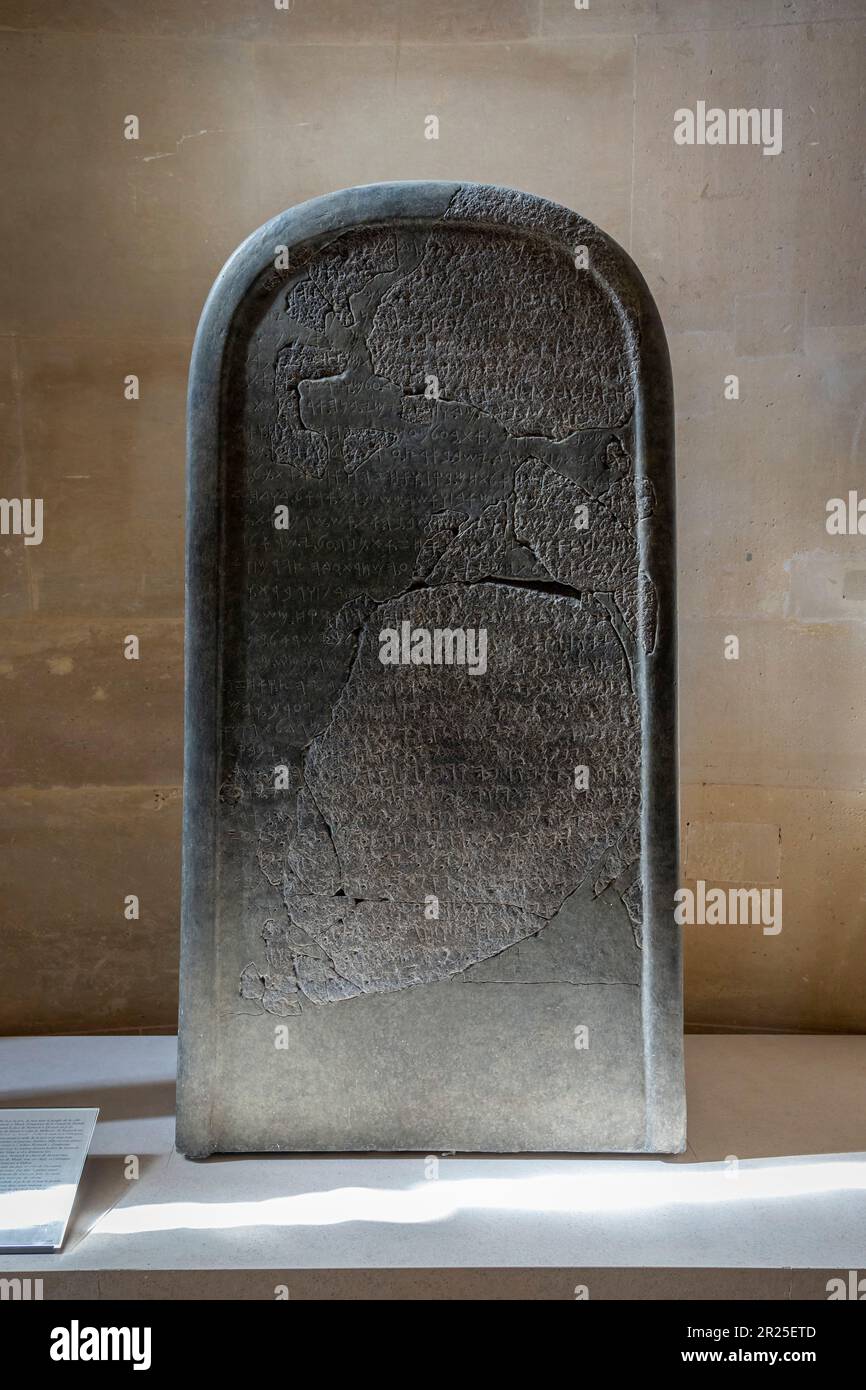 Paris, France - 05 13 2023: Louvre Museum. Stele of Mesha, kings of Moab, written in Moabite Stock Photohttps://www.alamy.com/image-license-details/?v=1https://www.alamy.com/paris-france-05-13-2023-louvre-museum-stele-of-mesha-kings-of-moab-written-in-moabite-image552082509.html
Paris, France - 05 13 2023: Louvre Museum. Stele of Mesha, kings of Moab, written in Moabite Stock Photohttps://www.alamy.com/image-license-details/?v=1https://www.alamy.com/paris-france-05-13-2023-louvre-museum-stele-of-mesha-kings-of-moab-written-in-moabite-image552082509.htmlRF2R25ETD–Paris, France - 05 13 2023: Louvre Museum. Stele of Mesha, kings of Moab, written in Moabite
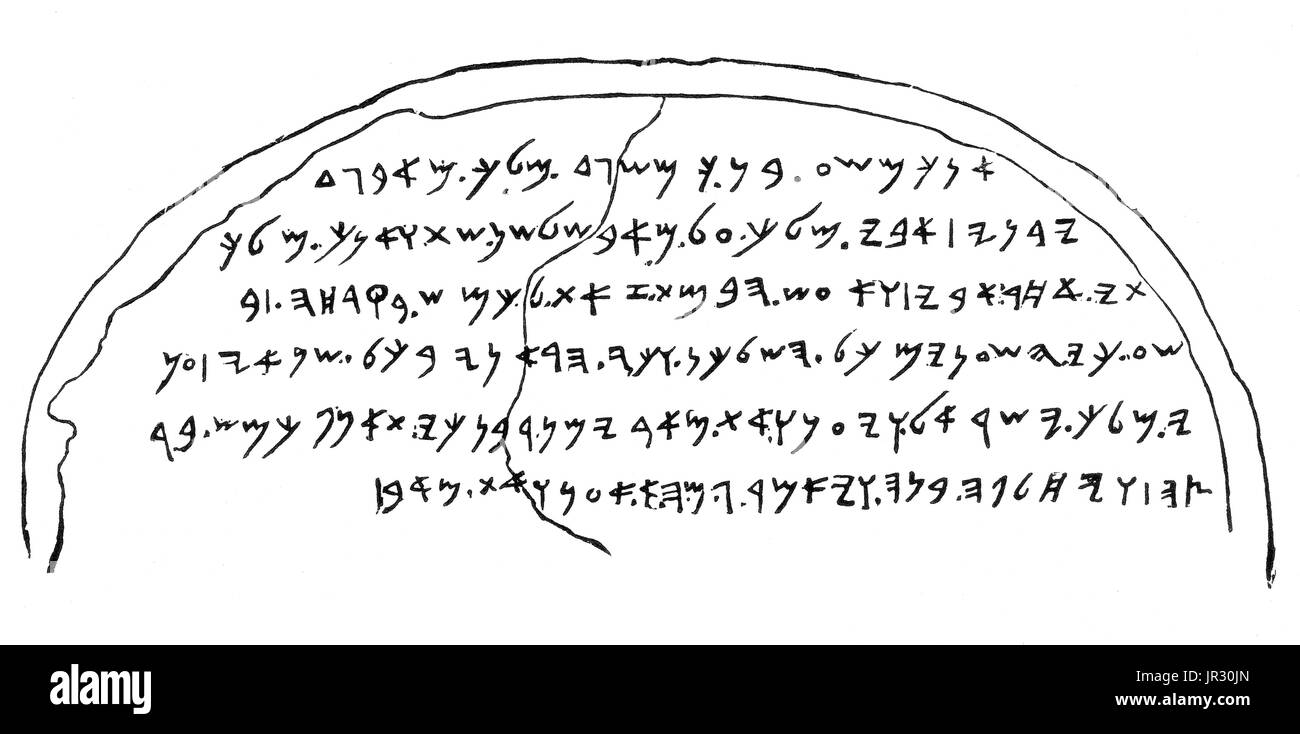 Mesha Stele AKA Moabite Stone,840 BC Stock Photohttps://www.alamy.com/image-license-details/?v=1https://www.alamy.com/mesha-stele-aka-moabite-stone840-bc-image151886413.html
Mesha Stele AKA Moabite Stone,840 BC Stock Photohttps://www.alamy.com/image-license-details/?v=1https://www.alamy.com/mesha-stele-aka-moabite-stone840-bc-image151886413.htmlRMJR30JN–Mesha Stele AKA Moabite Stone,840 BC
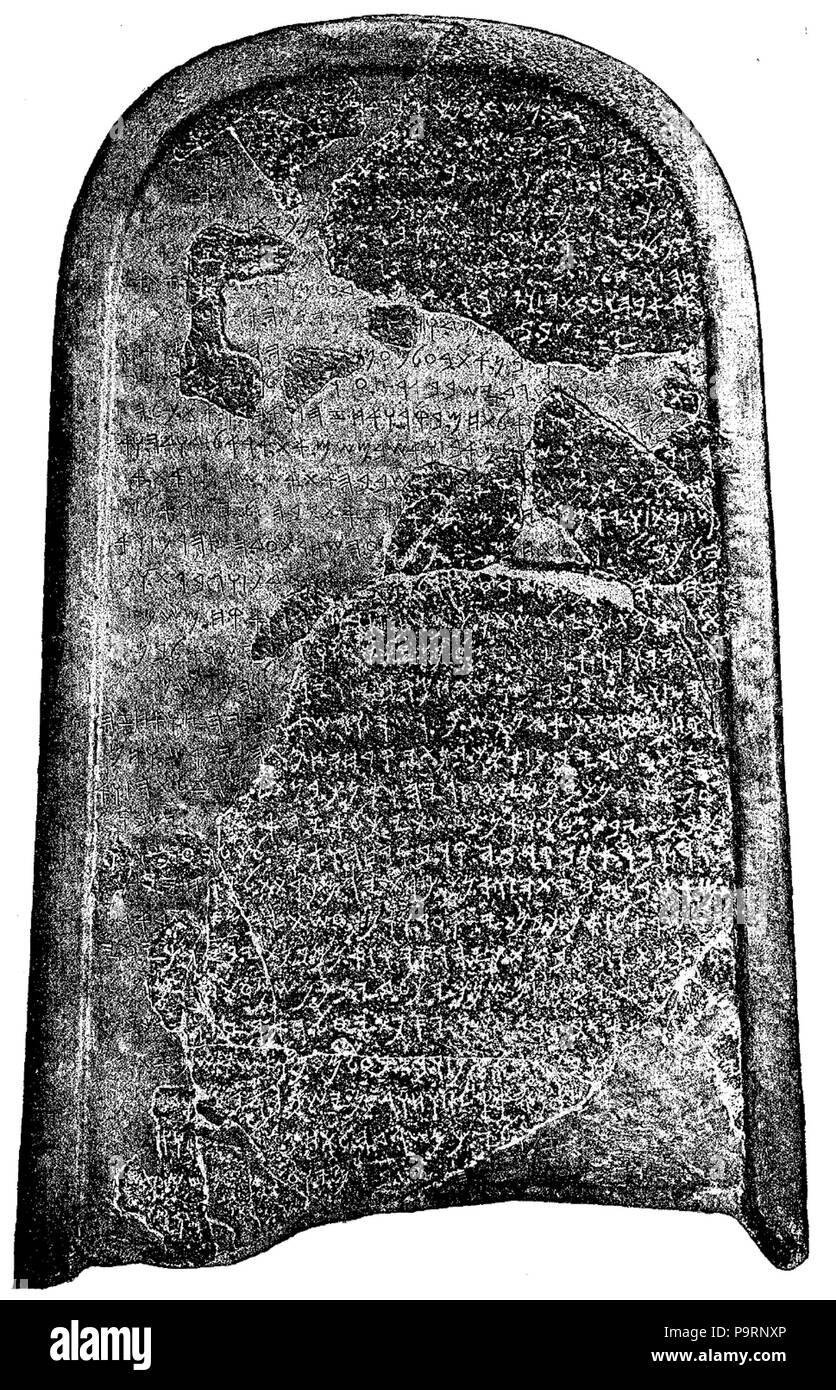 262 C+B-Mesha-MoabiteStone Stock Photohttps://www.alamy.com/image-license-details/?v=1https://www.alamy.com/262-cb-mesha-moabitestone-image212578430.html
262 C+B-Mesha-MoabiteStone Stock Photohttps://www.alamy.com/image-license-details/?v=1https://www.alamy.com/262-cb-mesha-moabitestone-image212578430.htmlRMP9RNXP–262 C+B-Mesha-MoabiteStone
 7496. Inscribed Moabite Altar from Khirbat Ataruz, Jordan, Mentions the Biblical Rebellion of Mesha, King of Moab who rebelled and won Ataroth from th Stock Photohttps://www.alamy.com/image-license-details/?v=1https://www.alamy.com/7496-inscribed-moabite-altar-from-khirbat-ataruz-jordan-mentions-the-biblical-rebellion-of-mesha-king-of-moab-who-rebelled-and-won-ataroth-from-th-image644206273.html
7496. Inscribed Moabite Altar from Khirbat Ataruz, Jordan, Mentions the Biblical Rebellion of Mesha, King of Moab who rebelled and won Ataroth from th Stock Photohttps://www.alamy.com/image-license-details/?v=1https://www.alamy.com/7496-inscribed-moabite-altar-from-khirbat-ataruz-jordan-mentions-the-biblical-rebellion-of-mesha-king-of-moab-who-rebelled-and-won-ataroth-from-th-image644206273.htmlRF2SC23JW–7496. Inscribed Moabite Altar from Khirbat Ataruz, Jordan, Mentions the Biblical Rebellion of Mesha, King of Moab who rebelled and won Ataroth from th
 Hours with the Bible; or The scriptures in the light of modern discovery and knowledge . deeds, but it was much more glorious to have crushed the terribleAgag. Led in chains, he was brought back with the army to graceits triumpli. Sauls early humility gave place to haughty pride atthe thought of such exploits. A memorial of these, raised in theoasis of Carrael, must commemorate his glory; most probably astone tablet like that of Mesha, the king of Moab,^ though Jeromefancied it was an arch of myrtles, palms, and olives. Meanwhile, avision had warned Sanuiel that the king had not fully performe Stock Photohttps://www.alamy.com/image-license-details/?v=1https://www.alamy.com/hours-with-the-bible-or-the-scriptures-in-the-light-of-modern-discovery-and-knowledge-deeds-but-it-was-much-more-glorious-to-have-crushed-the-terribleagag-led-in-chains-he-was-brought-back-with-the-army-to-graceits-triumpli-sauls-early-humility-gave-place-to-haughty-pride-atthe-thought-of-such-exploits-a-memorial-of-these-raised-in-theoasis-of-carrael-must-commemorate-his-glory-most-probably-astone-tablet-like-that-of-mesha-the-king-of-moab-though-jeromefancied-it-was-an-arch-of-myrtles-palms-and-olives-meanwhile-avision-had-warned-sanuiel-that-the-king-had-not-fully-performe-image342899893.html
Hours with the Bible; or The scriptures in the light of modern discovery and knowledge . deeds, but it was much more glorious to have crushed the terribleAgag. Led in chains, he was brought back with the army to graceits triumpli. Sauls early humility gave place to haughty pride atthe thought of such exploits. A memorial of these, raised in theoasis of Carrael, must commemorate his glory; most probably astone tablet like that of Mesha, the king of Moab,^ though Jeromefancied it was an arch of myrtles, palms, and olives. Meanwhile, avision had warned Sanuiel that the king had not fully performe Stock Photohttps://www.alamy.com/image-license-details/?v=1https://www.alamy.com/hours-with-the-bible-or-the-scriptures-in-the-light-of-modern-discovery-and-knowledge-deeds-but-it-was-much-more-glorious-to-have-crushed-the-terribleagag-led-in-chains-he-was-brought-back-with-the-army-to-graceits-triumpli-sauls-early-humility-gave-place-to-haughty-pride-atthe-thought-of-such-exploits-a-memorial-of-these-raised-in-theoasis-of-carrael-must-commemorate-his-glory-most-probably-astone-tablet-like-that-of-mesha-the-king-of-moab-though-jeromefancied-it-was-an-arch-of-myrtles-palms-and-olives-meanwhile-avision-had-warned-sanuiel-that-the-king-had-not-fully-performe-image342899893.htmlRM2AWTC8N–Hours with the Bible; or The scriptures in the light of modern discovery and knowledge . deeds, but it was much more glorious to have crushed the terribleAgag. Led in chains, he was brought back with the army to graceits triumpli. Sauls early humility gave place to haughty pride atthe thought of such exploits. A memorial of these, raised in theoasis of Carrael, must commemorate his glory; most probably astone tablet like that of Mesha, the king of Moab,^ though Jeromefancied it was an arch of myrtles, palms, and olives. Meanwhile, avision had warned Sanuiel that the king had not fully performe
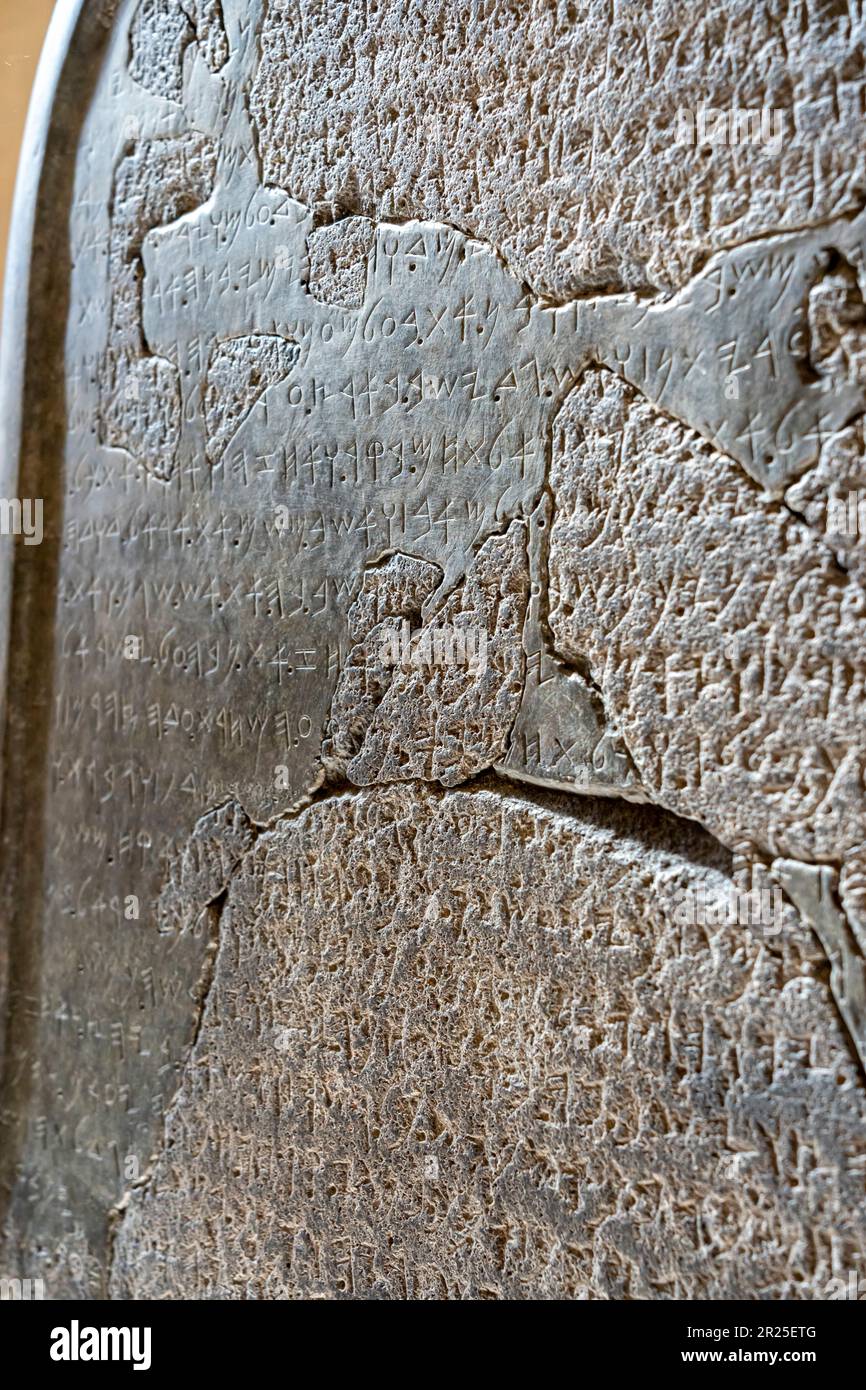 Paris, France - 05 13 2023: Louvre Museum. Stele of Mesha, kings of Moab, written in Moabite Stock Photohttps://www.alamy.com/image-license-details/?v=1https://www.alamy.com/paris-france-05-13-2023-louvre-museum-stele-of-mesha-kings-of-moab-written-in-moabite-image552082512.html
Paris, France - 05 13 2023: Louvre Museum. Stele of Mesha, kings of Moab, written in Moabite Stock Photohttps://www.alamy.com/image-license-details/?v=1https://www.alamy.com/paris-france-05-13-2023-louvre-museum-stele-of-mesha-kings-of-moab-written-in-moabite-image552082512.htmlRF2R25ETG–Paris, France - 05 13 2023: Louvre Museum. Stele of Mesha, kings of Moab, written in Moabite
 399 D116-stèle de Mesa, roi de Moab.-L2-Ch5 Stock Photohttps://www.alamy.com/image-license-details/?v=1https://www.alamy.com/399-d116-stle-de-mesa-roi-de-moab-l2-ch5-image210194167.html
399 D116-stèle de Mesa, roi de Moab.-L2-Ch5 Stock Photohttps://www.alamy.com/image-license-details/?v=1https://www.alamy.com/399-d116-stle-de-mesa-roi-de-moab-l2-ch5-image210194167.htmlRMP5Y4PF–399 D116-stèle de Mesa, roi de Moab.-L2-Ch5
 7496. Inscribed Moabite Altar from Khirbat Ataruz, Jordan, Mentions the Biblical Rebellion of Mesha, King of Moab who rebelled and won Ataroth from th Stock Photohttps://www.alamy.com/image-license-details/?v=1https://www.alamy.com/7496-inscribed-moabite-altar-from-khirbat-ataruz-jordan-mentions-the-biblical-rebellion-of-mesha-king-of-moab-who-rebelled-and-won-ataroth-from-th-image644206276.html
7496. Inscribed Moabite Altar from Khirbat Ataruz, Jordan, Mentions the Biblical Rebellion of Mesha, King of Moab who rebelled and won Ataroth from th Stock Photohttps://www.alamy.com/image-license-details/?v=1https://www.alamy.com/7496-inscribed-moabite-altar-from-khirbat-ataruz-jordan-mentions-the-biblical-rebellion-of-mesha-king-of-moab-who-rebelled-and-won-ataroth-from-th-image644206276.htmlRF2SC23K0–7496. Inscribed Moabite Altar from Khirbat Ataruz, Jordan, Mentions the Biblical Rebellion of Mesha, King of Moab who rebelled and won Ataroth from th
 Triumphs and wonders of the 19th century, the true mirror of a phenomenal era, a volume of original, entertaining and instructive historic and descriptive writings, showing the many and marvellous achievements which distinguish an hundred years of material, intellectual, social and moral progress .. . THE BLACK OBEEISK OF 8HAL-MANESER II., KING OP ASSYRIA. b. c 860-824. (British Museum.). THE MOABTTE STONE. ABOUT B. C. 850. (Paris, Museum qfth Louvre.) Monument dedicated to the god Kem6sh by Mesha, king of Moab (2 Kings :: : 4 ft.», to record hisvictory over the Israelite- in tie lays of Ahab, Stock Photohttps://www.alamy.com/image-license-details/?v=1https://www.alamy.com/triumphs-and-wonders-of-the-19th-century-the-true-mirror-of-a-phenomenal-era-a-volume-of-original-entertaining-and-instructive-historic-and-descriptive-writings-showing-the-many-and-marvellous-achievements-which-distinguish-an-hundred-years-of-material-intellectual-social-and-moral-progress-the-black-obeeisk-of-8hal-maneser-ii-king-op-assyria-b-c-860-824-british-museum-the-moabtte-stone-about-b-c-850-paris-museum-qfth-louvre-monument-dedicated-to-the-god-kem6sh-by-mesha-king-of-moab-2-kings-4-ft-to-record-hisvictory-over-the-israelite-in-tie-lays-of-ahab-image338229165.html
Triumphs and wonders of the 19th century, the true mirror of a phenomenal era, a volume of original, entertaining and instructive historic and descriptive writings, showing the many and marvellous achievements which distinguish an hundred years of material, intellectual, social and moral progress .. . THE BLACK OBEEISK OF 8HAL-MANESER II., KING OP ASSYRIA. b. c 860-824. (British Museum.). THE MOABTTE STONE. ABOUT B. C. 850. (Paris, Museum qfth Louvre.) Monument dedicated to the god Kem6sh by Mesha, king of Moab (2 Kings :: : 4 ft.», to record hisvictory over the Israelite- in tie lays of Ahab, Stock Photohttps://www.alamy.com/image-license-details/?v=1https://www.alamy.com/triumphs-and-wonders-of-the-19th-century-the-true-mirror-of-a-phenomenal-era-a-volume-of-original-entertaining-and-instructive-historic-and-descriptive-writings-showing-the-many-and-marvellous-achievements-which-distinguish-an-hundred-years-of-material-intellectual-social-and-moral-progress-the-black-obeeisk-of-8hal-maneser-ii-king-op-assyria-b-c-860-824-british-museum-the-moabtte-stone-about-b-c-850-paris-museum-qfth-louvre-monument-dedicated-to-the-god-kem6sh-by-mesha-king-of-moab-2-kings-4-ft-to-record-hisvictory-over-the-israelite-in-tie-lays-of-ahab-image338229165.htmlRM2AJ7JN1–Triumphs and wonders of the 19th century, the true mirror of a phenomenal era, a volume of original, entertaining and instructive historic and descriptive writings, showing the many and marvellous achievements which distinguish an hundred years of material, intellectual, social and moral progress .. . THE BLACK OBEEISK OF 8HAL-MANESER II., KING OP ASSYRIA. b. c 860-824. (British Museum.). THE MOABTTE STONE. ABOUT B. C. 850. (Paris, Museum qfth Louvre.) Monument dedicated to the god Kem6sh by Mesha, king of Moab (2 Kings :: : 4 ft.», to record hisvictory over the Israelite- in tie lays of Ahab,
 7496. Inscribed Moabite Altar from Khirbat Ataruz, Jordan, Mentions the Biblical Rebellion of Mesha, King of Moab who rebelled and won Ataroth from th Stock Photohttps://www.alamy.com/image-license-details/?v=1https://www.alamy.com/7496-inscribed-moabite-altar-from-khirbat-ataruz-jordan-mentions-the-biblical-rebellion-of-mesha-king-of-moab-who-rebelled-and-won-ataroth-from-th-image644206278.html
7496. Inscribed Moabite Altar from Khirbat Ataruz, Jordan, Mentions the Biblical Rebellion of Mesha, King of Moab who rebelled and won Ataroth from th Stock Photohttps://www.alamy.com/image-license-details/?v=1https://www.alamy.com/7496-inscribed-moabite-altar-from-khirbat-ataruz-jordan-mentions-the-biblical-rebellion-of-mesha-king-of-moab-who-rebelled-and-won-ataroth-from-th-image644206278.htmlRF2SC23K2–7496. Inscribed Moabite Altar from Khirbat Ataruz, Jordan, Mentions the Biblical Rebellion of Mesha, King of Moab who rebelled and won Ataroth from th
 . Modern research as illustrating the Bible . sacrificing children for the purpose of eitherappeasing the anger, or obtaining the help, of the national deity.In the second book of Kings (iii. 27) we read that Mesha, king ofMoab, when hard pressed by the invading Israelites, sacrificed hiseldest son to Chemosh, the national god of Moab. The practicefound its way into Judah under the later kings, especially Ahaz andManasseh, and is often alluded to by the prophets of the seventhcentury B. c. Thus Micah, in a well-known passage (vi. 7), representsan Israelite as asking— Shall I give my firstborn Stock Photohttps://www.alamy.com/image-license-details/?v=1https://www.alamy.com/modern-research-as-illustrating-the-bible-sacrificing-children-for-the-purpose-of-eitherappeasing-the-anger-or-obtaining-the-help-of-the-national-deityin-the-second-book-of-kings-iii-27-we-read-that-mesha-king-ofmoab-when-hard-pressed-by-the-invading-israelites-sacrificed-hiseldest-son-to-chemosh-the-national-god-of-moab-the-practicefound-its-way-into-judah-under-the-later-kings-especially-ahaz-andmanasseh-and-is-often-alluded-to-by-the-prophets-of-the-seventhcentury-b-c-thus-micah-in-a-well-known-passage-vi-7-representsan-israelite-as-asking-shall-i-give-my-firstborn-image372406805.html
. Modern research as illustrating the Bible . sacrificing children for the purpose of eitherappeasing the anger, or obtaining the help, of the national deity.In the second book of Kings (iii. 27) we read that Mesha, king ofMoab, when hard pressed by the invading Israelites, sacrificed hiseldest son to Chemosh, the national god of Moab. The practicefound its way into Judah under the later kings, especially Ahaz andManasseh, and is often alluded to by the prophets of the seventhcentury B. c. Thus Micah, in a well-known passage (vi. 7), representsan Israelite as asking— Shall I give my firstborn Stock Photohttps://www.alamy.com/image-license-details/?v=1https://www.alamy.com/modern-research-as-illustrating-the-bible-sacrificing-children-for-the-purpose-of-eitherappeasing-the-anger-or-obtaining-the-help-of-the-national-deityin-the-second-book-of-kings-iii-27-we-read-that-mesha-king-ofmoab-when-hard-pressed-by-the-invading-israelites-sacrificed-hiseldest-son-to-chemosh-the-national-god-of-moab-the-practicefound-its-way-into-judah-under-the-later-kings-especially-ahaz-andmanasseh-and-is-often-alluded-to-by-the-prophets-of-the-seventhcentury-b-c-thus-micah-in-a-well-known-passage-vi-7-representsan-israelite-as-asking-shall-i-give-my-firstborn-image372406805.htmlRM2CHTGK1–. Modern research as illustrating the Bible . sacrificing children for the purpose of eitherappeasing the anger, or obtaining the help, of the national deity.In the second book of Kings (iii. 27) we read that Mesha, king ofMoab, when hard pressed by the invading Israelites, sacrificed hiseldest son to Chemosh, the national god of Moab. The practicefound its way into Judah under the later kings, especially Ahaz andManasseh, and is often alluded to by the prophets of the seventhcentury B. c. Thus Micah, in a well-known passage (vi. 7), representsan Israelite as asking— Shall I give my firstborn
 229. MESHA STELE, A MOABITE INSCRIPTION DATING CA. 840-820 B.C. RECOUNTING THE EXPLOITS OF MESHA KING OF MOAB.YHWH, the god of Israelites as mentioned Stock Photohttps://www.alamy.com/image-license-details/?v=1https://www.alamy.com/229-mesha-stele-a-moabite-inscription-dating-ca-840-820-bc-recounting-the-exploits-of-mesha-king-of-moabyhwh-the-god-of-israelites-as-mentioned-image689893753.html
229. MESHA STELE, A MOABITE INSCRIPTION DATING CA. 840-820 B.C. RECOUNTING THE EXPLOITS OF MESHA KING OF MOAB.YHWH, the god of Israelites as mentioned Stock Photohttps://www.alamy.com/image-license-details/?v=1https://www.alamy.com/229-mesha-stele-a-moabite-inscription-dating-ca-840-820-bc-recounting-the-exploits-of-mesha-king-of-moabyhwh-the-god-of-israelites-as-mentioned-image689893753.htmlRF3C2BAEH–229. MESHA STELE, A MOABITE INSCRIPTION DATING CA. 840-820 B.C. RECOUNTING THE EXPLOITS OF MESHA KING OF MOAB.YHWH, the god of Israelites as mentioned
 . The Holman new self-pronouncing Sunday-school teachers Bible . THE Plate 4.MOABITE STONE. (Paris, Museum of the Louvre.) Monument dedicated to the god Kemosh by Mesha, king of Moab, about B. C. 890, to record his victoryover the Israelites in the days of Ahab, and the restoration of cities and other works which he undertook bycommand of his god. The stone, which measures 3 ft. 10 in.X2 ft.Xi43^ in., and contains 34 lines of inscrip-tion in the Phoenician character, was found at DibHan in the land of Moab in 1868. It was unfortunatelybroken in pieces, but about two-thirds of the fragments wer Stock Photohttps://www.alamy.com/image-license-details/?v=1https://www.alamy.com/the-holman-new-self-pronouncing-sunday-school-teachers-bible-the-plate-4moabite-stone-paris-museum-of-the-louvre-monument-dedicated-to-the-god-kemosh-by-mesha-king-of-moab-about-b-c-890-to-record-his-victoryover-the-israelites-in-the-days-of-ahab-and-the-restoration-of-cities-and-other-works-which-he-undertook-bycommand-of-his-god-the-stone-which-measures-3-ft-10-inx2-ftxi43-in-and-contains-34-lines-of-inscrip-tion-in-the-phoenician-character-was-found-at-dibhan-in-the-land-of-moab-in-1868-it-was-unfortunatelybroken-in-pieces-but-about-two-thirds-of-the-fragments-wer-image369831350.html
. The Holman new self-pronouncing Sunday-school teachers Bible . THE Plate 4.MOABITE STONE. (Paris, Museum of the Louvre.) Monument dedicated to the god Kemosh by Mesha, king of Moab, about B. C. 890, to record his victoryover the Israelites in the days of Ahab, and the restoration of cities and other works which he undertook bycommand of his god. The stone, which measures 3 ft. 10 in.X2 ft.Xi43^ in., and contains 34 lines of inscrip-tion in the Phoenician character, was found at DibHan in the land of Moab in 1868. It was unfortunatelybroken in pieces, but about two-thirds of the fragments wer Stock Photohttps://www.alamy.com/image-license-details/?v=1https://www.alamy.com/the-holman-new-self-pronouncing-sunday-school-teachers-bible-the-plate-4moabite-stone-paris-museum-of-the-louvre-monument-dedicated-to-the-god-kemosh-by-mesha-king-of-moab-about-b-c-890-to-record-his-victoryover-the-israelites-in-the-days-of-ahab-and-the-restoration-of-cities-and-other-works-which-he-undertook-bycommand-of-his-god-the-stone-which-measures-3-ft-10-inx2-ftxi43-in-and-contains-34-lines-of-inscrip-tion-in-the-phoenician-character-was-found-at-dibhan-in-the-land-of-moab-in-1868-it-was-unfortunatelybroken-in-pieces-but-about-two-thirds-of-the-fragments-wer-image369831350.htmlRM2CDK7JE–. The Holman new self-pronouncing Sunday-school teachers Bible . THE Plate 4.MOABITE STONE. (Paris, Museum of the Louvre.) Monument dedicated to the god Kemosh by Mesha, king of Moab, about B. C. 890, to record his victoryover the Israelites in the days of Ahab, and the restoration of cities and other works which he undertook bycommand of his god. The stone, which measures 3 ft. 10 in.X2 ft.Xi43^ in., and contains 34 lines of inscrip-tion in the Phoenician character, was found at DibHan in the land of Moab in 1868. It was unfortunatelybroken in pieces, but about two-thirds of the fragments wer
 229. MESHA STELE, A MOABITE INSCRIPTION DATING CA. 840-820 B.C. RECOUNTING THE EXPLOITS OF MESHA KING OF MOAB.YHWH, the god of Israelites as mentioned Stock Photohttps://www.alamy.com/image-license-details/?v=1https://www.alamy.com/229-mesha-stele-a-moabite-inscription-dating-ca-840-820-bc-recounting-the-exploits-of-mesha-king-of-moabyhwh-the-god-of-israelites-as-mentioned-image672872187.html
229. MESHA STELE, A MOABITE INSCRIPTION DATING CA. 840-820 B.C. RECOUNTING THE EXPLOITS OF MESHA KING OF MOAB.YHWH, the god of Israelites as mentioned Stock Photohttps://www.alamy.com/image-license-details/?v=1https://www.alamy.com/229-mesha-stele-a-moabite-inscription-dating-ca-840-820-bc-recounting-the-exploits-of-mesha-king-of-moabyhwh-the-god-of-israelites-as-mentioned-image672872187.htmlRF3B2KY9F–229. MESHA STELE, A MOABITE INSCRIPTION DATING CA. 840-820 B.C. RECOUNTING THE EXPLOITS OF MESHA KING OF MOAB.YHWH, the god of Israelites as mentioned
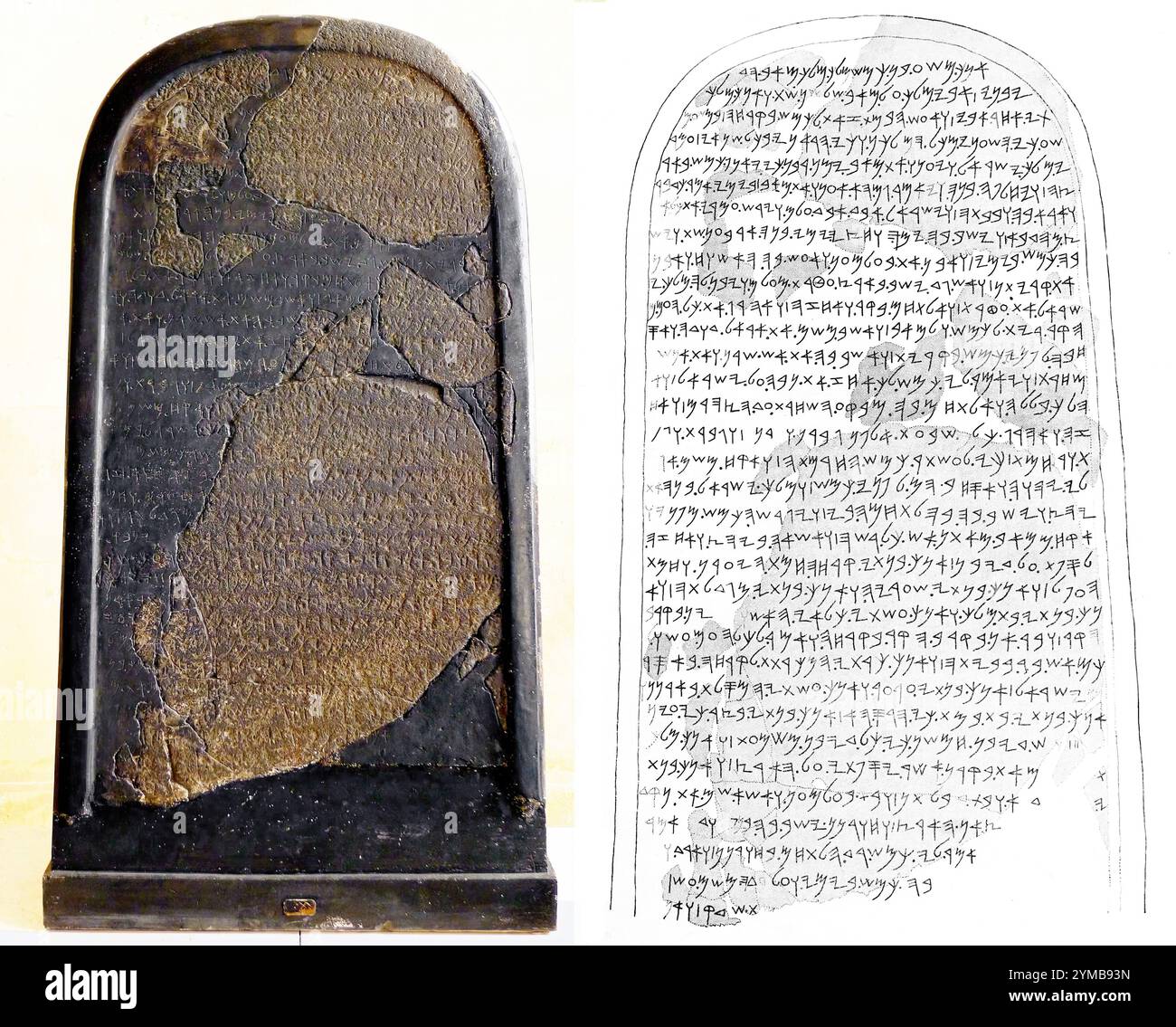 229. MESHA STELE, A MOABITE INSCRIPTION DATING CA. 840-820 B.C. RECOUNTING THE EXPLOITS OF MESHA KING OF MOAB Stock Photohttps://www.alamy.com/image-license-details/?v=1https://www.alamy.com/229-mesha-stele-a-moabite-inscription-dating-ca-840-820-bc-recounting-the-exploits-of-mesha-king-of-moab-image632115001.html
229. MESHA STELE, A MOABITE INSCRIPTION DATING CA. 840-820 B.C. RECOUNTING THE EXPLOITS OF MESHA KING OF MOAB Stock Photohttps://www.alamy.com/image-license-details/?v=1https://www.alamy.com/229-mesha-stele-a-moabite-inscription-dating-ca-840-820-bc-recounting-the-exploits-of-mesha-king-of-moab-image632115001.htmlRM2YMB93N–229. MESHA STELE, A MOABITE INSCRIPTION DATING CA. 840-820 B.C. RECOUNTING THE EXPLOITS OF MESHA KING OF MOAB
 . God, the Bible, truth and Christian theology . Platb IV.—the MOABITE STONE.(Paris, Museum of the Louvre.)Monument dedicated to the god Kemosh by Mesha, king of Moab, about B. c. 850, to record Viisvictory over the Israelites in the days of Ahab, and the resforation of cities and* other works whichhe undertook by command of his god. The stone,which measures 3 ft. join, x 2 ft.x 14,^ in., andcontains 34 lines of inscription in the Phoenician character, was found at Dibhanin the land of MoabIn i20S. It was unionunately broken in pieces, but about two-thirds of the fragments were recover-ed, and Stock Photohttps://www.alamy.com/image-license-details/?v=1https://www.alamy.com/god-the-bible-truth-and-christian-theology-platb-ivthe-moabite-stoneparis-museum-of-the-louvremonument-dedicated-to-the-god-kemosh-by-mesha-king-of-moab-about-b-c-850-to-record-viisvictory-over-the-israelites-in-the-days-of-ahab-and-the-resforation-of-cities-and-other-works-whichhe-undertook-by-command-of-his-god-the-stonewhich-measures-3-ft-join-x-2-ftx-14-in-andcontains-34-lines-of-inscription-in-the-phoenician-character-was-found-at-dibhanin-the-land-of-moabin-i20s-it-was-unionunately-broken-in-pieces-but-about-two-thirds-of-the-fragments-were-recover-ed-and-image371864449.html
. God, the Bible, truth and Christian theology . Platb IV.—the MOABITE STONE.(Paris, Museum of the Louvre.)Monument dedicated to the god Kemosh by Mesha, king of Moab, about B. c. 850, to record Viisvictory over the Israelites in the days of Ahab, and the resforation of cities and* other works whichhe undertook by command of his god. The stone,which measures 3 ft. join, x 2 ft.x 14,^ in., andcontains 34 lines of inscription in the Phoenician character, was found at Dibhanin the land of MoabIn i20S. It was unionunately broken in pieces, but about two-thirds of the fragments were recover-ed, and Stock Photohttps://www.alamy.com/image-license-details/?v=1https://www.alamy.com/god-the-bible-truth-and-christian-theology-platb-ivthe-moabite-stoneparis-museum-of-the-louvremonument-dedicated-to-the-god-kemosh-by-mesha-king-of-moab-about-b-c-850-to-record-viisvictory-over-the-israelites-in-the-days-of-ahab-and-the-resforation-of-cities-and-other-works-whichhe-undertook-by-command-of-his-god-the-stonewhich-measures-3-ft-join-x-2-ftx-14-in-andcontains-34-lines-of-inscription-in-the-phoenician-character-was-found-at-dibhanin-the-land-of-moabin-i20s-it-was-unionunately-broken-in-pieces-but-about-two-thirds-of-the-fragments-were-recover-ed-and-image371864449.htmlRM2CGYTW5–. God, the Bible, truth and Christian theology . Platb IV.—the MOABITE STONE.(Paris, Museum of the Louvre.)Monument dedicated to the god Kemosh by Mesha, king of Moab, about B. c. 850, to record Viisvictory over the Israelites in the days of Ahab, and the resforation of cities and* other works whichhe undertook by command of his god. The stone,which measures 3 ft. join, x 2 ft.x 14,^ in., andcontains 34 lines of inscription in the Phoenician character, was found at Dibhanin the land of MoabIn i20S. It was unionunately broken in pieces, but about two-thirds of the fragments were recover-ed, and
 . The Holy Bible containing the Old and New Testaments ... Plate IV.—THE MOABITE STONE.(Paris, Museum of the Louvre.)Monument dedicated to the god Kemosh by Mesha, king of Moab, about b. c. 890, to record hisvictory over the Israelites in the days of Ahab, and the restoration of cities and other works whichhe undertook by command of his god. The stone, which measures 3 ft. 10 in. x 2 ft. x 14^ in., andcontains 34 lines of inscription in the Phoenician character, was found at Dibhan in the land of Moabin 1868. It was unfortunately broken in pieces, but about two-thirds of the fragments were rec Stock Photohttps://www.alamy.com/image-license-details/?v=1https://www.alamy.com/the-holy-bible-containing-the-old-and-new-testaments-plate-ivthe-moabite-stoneparis-museum-of-the-louvremonument-dedicated-to-the-god-kemosh-by-mesha-king-of-moab-about-b-c-890-to-record-hisvictory-over-the-israelites-in-the-days-of-ahab-and-the-restoration-of-cities-and-other-works-whichhe-undertook-by-command-of-his-god-the-stone-which-measures-3-ft-10-in-x-2-ft-x-14-in-andcontains-34-lines-of-inscription-in-the-phoenician-character-was-found-at-dibhan-in-the-land-of-moabin-1868-it-was-unfortunately-broken-in-pieces-but-about-two-thirds-of-the-fragments-were-rec-image370473257.html
. The Holy Bible containing the Old and New Testaments ... Plate IV.—THE MOABITE STONE.(Paris, Museum of the Louvre.)Monument dedicated to the god Kemosh by Mesha, king of Moab, about b. c. 890, to record hisvictory over the Israelites in the days of Ahab, and the restoration of cities and other works whichhe undertook by command of his god. The stone, which measures 3 ft. 10 in. x 2 ft. x 14^ in., andcontains 34 lines of inscription in the Phoenician character, was found at Dibhan in the land of Moabin 1868. It was unfortunately broken in pieces, but about two-thirds of the fragments were rec Stock Photohttps://www.alamy.com/image-license-details/?v=1https://www.alamy.com/the-holy-bible-containing-the-old-and-new-testaments-plate-ivthe-moabite-stoneparis-museum-of-the-louvremonument-dedicated-to-the-god-kemosh-by-mesha-king-of-moab-about-b-c-890-to-record-hisvictory-over-the-israelites-in-the-days-of-ahab-and-the-restoration-of-cities-and-other-works-whichhe-undertook-by-command-of-his-god-the-stone-which-measures-3-ft-10-in-x-2-ft-x-14-in-andcontains-34-lines-of-inscription-in-the-phoenician-character-was-found-at-dibhan-in-the-land-of-moabin-1868-it-was-unfortunately-broken-in-pieces-but-about-two-thirds-of-the-fragments-were-rec-image370473257.htmlRM2CEMEBN–. The Holy Bible containing the Old and New Testaments ... Plate IV.—THE MOABITE STONE.(Paris, Museum of the Louvre.)Monument dedicated to the god Kemosh by Mesha, king of Moab, about b. c. 890, to record hisvictory over the Israelites in the days of Ahab, and the restoration of cities and other works whichhe undertook by command of his god. The stone, which measures 3 ft. 10 in. x 2 ft. x 14^ in., andcontains 34 lines of inscription in the Phoenician character, was found at Dibhan in the land of Moabin 1868. It was unfortunately broken in pieces, but about two-thirds of the fragments were rec
 . Stories from the Hebrew . MESHA, THE KING OF MOAB 117 camp of the Israelites for the spoil. But they weremet by the three kings, who rose up and smote themso that they fled before them. When Mesha, the kingof Moab, saw that the battle was too sore for him, heand seven hundred swordsmen tried to break throughthe lines, but they could not. Every man of them wasslain. Thus was Israel able to conquer Moab, because ofthe power of Elisha, the prophet. XXII—NAAMAN. AAMAN1 was a greatand honorable captainof the Syrian king, buthe was a leper. Naa-mans wife was waitedupon by a little maid whowas brou Stock Photohttps://www.alamy.com/image-license-details/?v=1https://www.alamy.com/stories-from-the-hebrew-mesha-the-king-of-moab-117-camp-of-the-israelites-for-the-spoil-but-they-weremet-by-the-three-kings-who-rose-up-and-smote-themso-that-they-fled-before-them-when-mesha-the-kingof-moab-saw-that-the-battle-was-too-sore-for-him-heand-seven-hundred-swordsmen-tried-to-break-throughthe-lines-but-they-could-not-every-man-of-them-wasslain-thus-was-israel-able-to-conquer-moab-because-ofthe-power-of-elisha-the-prophet-xxiinaaman-aaman1-was-a-greatand-honorable-captainof-the-syrian-king-buthe-was-a-leper-naa-mans-wife-was-waitedupon-by-a-little-maid-whowas-brou-image372327393.html
. Stories from the Hebrew . MESHA, THE KING OF MOAB 117 camp of the Israelites for the spoil. But they weremet by the three kings, who rose up and smote themso that they fled before them. When Mesha, the kingof Moab, saw that the battle was too sore for him, heand seven hundred swordsmen tried to break throughthe lines, but they could not. Every man of them wasslain. Thus was Israel able to conquer Moab, because ofthe power of Elisha, the prophet. XXII—NAAMAN. AAMAN1 was a greatand honorable captainof the Syrian king, buthe was a leper. Naa-mans wife was waitedupon by a little maid whowas brou Stock Photohttps://www.alamy.com/image-license-details/?v=1https://www.alamy.com/stories-from-the-hebrew-mesha-the-king-of-moab-117-camp-of-the-israelites-for-the-spoil-but-they-weremet-by-the-three-kings-who-rose-up-and-smote-themso-that-they-fled-before-them-when-mesha-the-kingof-moab-saw-that-the-battle-was-too-sore-for-him-heand-seven-hundred-swordsmen-tried-to-break-throughthe-lines-but-they-could-not-every-man-of-them-wasslain-thus-was-israel-able-to-conquer-moab-because-ofthe-power-of-elisha-the-prophet-xxiinaaman-aaman1-was-a-greatand-honorable-captainof-the-syrian-king-buthe-was-a-leper-naa-mans-wife-was-waitedupon-by-a-little-maid-whowas-brou-image372327393.htmlRM2CHMYAW–. Stories from the Hebrew . MESHA, THE KING OF MOAB 117 camp of the Israelites for the spoil. But they weremet by the three kings, who rose up and smote themso that they fled before them. When Mesha, the kingof Moab, saw that the battle was too sore for him, heand seven hundred swordsmen tried to break throughthe lines, but they could not. Every man of them wasslain. Thus was Israel able to conquer Moab, because ofthe power of Elisha, the prophet. XXII—NAAMAN. AAMAN1 was a greatand honorable captainof the Syrian king, buthe was a leper. Naa-mans wife was waitedupon by a little maid whowas brou